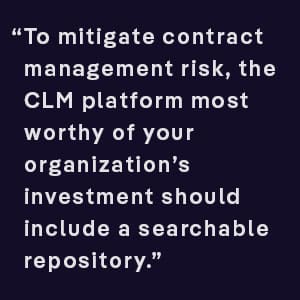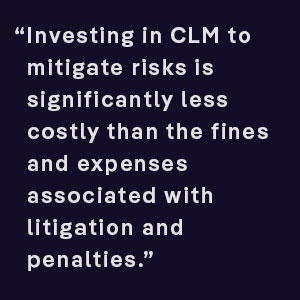Running virtually any business — even working for one — carries plenty of risks. Yet, as former U.S. President Theodore Roosevelt once said: “Risk is like fire. If controlled, it will help you. If uncontrolled, it will rise up and destroy you.”
Organizations that apply contract management best practices to control risk are quite successful, generally speaking. Others fail to recognize the dangers of jumping into business relationships with both feet and eyes closed. Or their company doesn’t deliver on the obligations they promised to meet, and those responsible pay the price later.
Of course, contracts — in and of themselves — do not guarantee successful outcomes. They describe the terms of successful delivery or how each party will be accountable to the other if terms are not met. Mitigating contract management risk, then, requires the right mix of people, processes, and technology. Your executives and employees need to understand modern contracting processes, and you need to digitally transform those processes with legal technology.
Ultimately, though, legal teams and others need to commit to controlling risk and understanding the ramifications of allowing risk to run its course — completely unchecked.
Why It’s Important to Monitor For Contract Management Risks
Employing an intelligent, intuitive contract management platform — with predictive, AI-powered analytics — is like looking at your business through a pair of high-powered binoculars with night vision! The system helps you identify the trouble up ahead, such as obligations or milestones that are in jeopardy. It can alert your contract management team to agreements nearing expiry or trends like contract revenue falling short of expectations.
So, monitoring contract performance — by reviewing reliable, real-time data — is critical for companies to hit their revenue forecasts, maintain their reputation, and minimize liability. Whether your organization is on the supply or buy-side of your contracts, making sure each party lives up to their promises is crucial throughout the contract lifecycle.
Common Types of Contract Management Risks
Failure to create reusable contract templates and approved language that protects your company’s interests is flat-out risky. You cannot focus on protecting yourself from one kind of risk or another and simply hope for the best.
Here are the leading kinds of contract management risk pitfalls. These should compel you and your team to carefully author and thoroughly review any contract in which your company engages.
Financial Risks
Perhaps during contract negotiation, the risk of a penalty for non-performance or not meeting your service level commitments, milestones, or product quality obligations may not alarm you. Yet, a small error or unforeseen event can derail a project or delay a shipment. If your agreements do not adequately protect your business from financial risks, you may have to pay back the full value of the contract — or even more.
It is best, then, to ensure your agreements — including statements of work, warranties, licensing, purchase orders, and sales agreements — are not just written for ideal circumstances. Instead, add some caveats and protections in case accidents happen.
Security Risks
Data security and privacy risk are increasing concerns across all companies and industries. Data breaches happen every minute of the day, and every kind of business and institution is a potential target for external and internal threats. According to Forbes, more than a quarter of a billion people were victims of data breaches in 2021, and worldwide cybercrime costs companies $1.79 million per minute, every day.
Regulated industries, like financial services, government, and health care, have some of the highest standards, like HIPAA and SOC 2, and protections against external hackers. Yet, users continue to fall victim to phishing attacks, social engineering, bribes, and coercion to expose their employers’ sensitive information. You would do well to invest in a contract lifecycle management (CLM) solution that has strict controls over permissions, digital rights, and the highest levels of encryption and identity management.
Legal Risks
Legal contract management risks can occur in the form of fines for not complying with industry regulations, like meeting GDPR or environmental protection standards. Many businesses end up in civil court because they fail to meet their contractual obligations.
Accordingly, ensuring your business contracts state that they are subject to the laws of your federal, state, and local laws is important. And reviewing the details of your own contracts — and those of the parties you do business with — is crucial. However, an AI-powered contract review helps to mitigate the risk of your company agreeing to unacceptable terms. And generally, the investment you make in minimizing your risk with contract management technology is significantly less costly than the fines and expenses associated with litigation and penalties.
Brand Risks
Face it, word can travel quickly — in the digital age — when a company fails to meet its contractual obligations or when its executives or brand ambassadors shift public perception. The Nuremberg Institute for Market Decisions cites brands, like Uber, Martha Stewart Living — and the companies that sponsored Tiger Woods during his fall from grace — as examples of the latter.
Employment contracts or professional contracts with influencers and public figures are increasingly carrying terms regarding what influencers say about a company. Others dictate how their products are presented on social media. Although many brands have healed their reputation over time, the cost of lost business and customer distrust can be devastating.
Other Contract Management Risks Your Team Needs to Monitor
Risk #1 – Missed contract renewals or win-back opportunities
Do not let customers think you do not value their business by neglecting to contact them long before their contract expires. A CLM platform, with alerts and automated workflows, ensures early notifications and reminders of lapsing support or subscription contracts.
Risk #2 – Open permissions to intellectual capital
CLM platforms offer rule-based and exclusive permission controls. Restrict contract information to employees on a need-to-know basis, based on their responsibilities and potential conflicts of interest. Data is exceedingly valuable here.
Risk #3 – Approval workflow bottlenecks
CLM platforms also help you create and enforce policies, processes, and safeguards, in case contract management processes meet unusual business. Establish tiered approval levels for price discounts or other financial decisions. Ensure workflows and policies align with compliance requirements, and mitigate audit exposures or fines.
Recap – How to Mitigate Contract Management Risk
- Use strong encryption to protect contract data — Employ 256-bit encryption and multi-factor authentication mechanisms
- Eliminate missed milestones and obligations — Use notifications and alerts
- Control access with role-based security — Understand the access based on responsibilities
- Use clause and template libraries to increase compliance
- Maintain control over contract versions — Keep redlined copies from negotiations, in case of litigation
- Leverage automated workflows to enforce business processes — Leave nothing to the imagination!
- Use E-Signatures to secure approvals — Speed up negotiation cycles and maintain digital continuity
Manage & Mitigate Contract Management Risks with Smart Contract Software
To mitigate contract management risk, the CLM platform most worthy of your organization’s investment should include:
- A searchable repository to make contract files and redlined versions discoverable when needed
- Contract authoring and review tools that streamline processes based on approved language
- A secure negotiation space in the cloud
- A powerful analytics engine that identifies risks before they become problematic
- Interoperability with other business applications, tools, and platforms for additional controls and context
Want to know more about enterprise CLM solutions and how they help mitigate various risk factors? Review our Contract Risk and Compliance datasheet today.
Author:

Edward Chick
Connect with us on Linkedin









